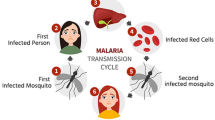Abstract
The development of an intelligent system for automated malaria detection became the one of challenges since its application supported the examination process which was conducted manually by the doctor or medical personnel. Some previous studies have been done to overcome those problems. However, most of them still have problem in detecting parasite candidates. Hence, their proposed methods did not successfully detect all parasite candidates and remains a large number of false-negative. Actually, the misdetection problem occurred since the characteristic of parasites seems unclear. To overcome these problems, we applied image processing technique and deep learning architecture to detect and to ensure whether the detected candidate is a parasite or not. Our proposed method was applied to 46 digital microscopic images provided by the Department of Parasitology, Universitas Gadjah Mada and Eijkman Institute for Molecular Biology. The proposed method comprised of four steps which are normalization process using GGB (green, green, blue) color transformation, segmentation process using Otsu followed by some morphological operations, object labelling using BLOB analysis, and classification using deep learning. Our detection process successfully detected all parasites and the classification process achieved an accuracy, sensitivity, specificity, PPV and NPV of 98.97, 100, 98.08, 97.85, and 100% respectively. This result shows that our proposed method achieved outstanding performance in both detection and classification process which indicates that our proposed method had the potential to be implemented as an intelligent system for supporting the parasitologist in conducting rapid assessment of plasmodium parasite infection.
Access this chapter
Tax calculation will be finalised at checkout
Purchases are for personal use only
Similar content being viewed by others
References
Preedanan W, Phothisonothai M, Senavongse W, Tantisatirapong S (2016) Automated detection of plasmodium falciparum from Giemsa-stained thin blood films. In: 2016 8th international conference on knowledge and smart technology (KST), pp 215–218
Nugroho HA, Nurfauzi R, Frannita EL (2019) Plasmodium candidate detection on thin blood smear images with luminance noise reduction. In: 2019 5th international conference on science in information technology (ICSITech), pp 146–149
Haryanto SEV, Mashor MY, Nasir ASA, Jaafar H (2017) A fast and accurate detection of Schizont plasmodium falciparum using channel color space segmentation method. In: 2017 5th international conference on cyber and IT service management (CITSM), pp 1–4
Gatc J, Maspiyanti F (2018) Plasmodium parasite detection on thin blood smear image using double thresholding and BLOB analysis. In: 2018 international conference on applied engineering (ICAE), pp 1–6
Peñas KED, Rivera PT, Naval PC (2017) Malaria parasite detection and species identification on thin blood smears using a convolutional neural network. In: 2017 IEEE/ACM international conference on connected health: applications, systems and engineering technologies (CHASE), pp 1–6
Nugroho HA, Imaroh K, Ardiyanto I, Frannita EL (2020) Automated detection of plasmodium ovale and malariae species on microscopic thin blood smear images. Int J Adv Soft Compu Appl 12
Mohammed HA, Abdelrahman IAM (2017) Detection and classification of Malaria in thin blood slide images. In: 2017 international conference on communication, control, computing and electronics engineering (ICCCCEE), pp 1–5
Prananda AR, Nugroho HA, Ardiyanto I (2019) Enumeration of plasmodium parasites on thin blood smear digital microscopic images. In: 2019 5th international conference on science in information technology (ICSITech), pp 223–228
Bibin D, Nair MS, Punitha P (2017) Malaria parasite detection from peripheral blood smear images using deep belief networks. IEEE Access 5:9099–9108
Kalkan SC, Sahingoz OK (2019) Deep learning based classification of malaria from slide images. In: 2019 scientific meeting on electrical-electronics & biomedical engineering and computer science (EBBT), pp 1–4
Var E, Tek FB (2018) Malaria parasite detection with deep transfer learning. In: 2018 3rd international conference on computer science and engineering (UBMK), pp 298–302. https://doi.org/10.1109/ubmk.2018.8566549
Dong Y, Jiang Z, Shen H, Pan WD (2017) Classification accuracies of malaria infected cells using deep convolutional neural networks based on decompressed images. In: SoutheastCon 2017, pp 1–6
Dong Y et al (2017) Evaluations of deep convolutional neural networks for automatic identification of malaria infected cells. In: 2017 IEEE EMBS international conference on biomedical & health informatics (BHI), pp 101–104
Hegde R, Prasad K, Hebbar H, Singh BM (2018) Development of a robust algorithm for detection of nuclei and classification of white blood cells in peripheral blood smear images. J Med Syst 42
Otsu N (1979) A threshold selection method from gray-level histograms. IEEE Trans Syst Man Cybern 9:62–66
Davies ERBT-CV (ed) (2018) Chapter 3—Image filtering and morphology (Fifth ed). Academic Press, pp 39–92
Nugroho HA, Saputra WA, Permanasari AE, Murhandarwati EEH (2017) Automated determination of plasmodium region of interest on thin blood smear images. In: 2017 international seminar on intelligent technology and its applications (ISITIA), pp 352–355
Acknowledgements
This study is funded by Directorate General of Higher Education, Ministry of Research, Technology and Higher Education through the Research Grant of “Penelitian Dasar Unggulan Perguruan Tinggi”. The authors would also like to thank Intelligent System research group in Department of Electrical and Information Engineering for inspiring discussion and motivation.
Author information
Authors and Affiliations
Corresponding author
Editor information
Editors and Affiliations
Rights and permissions
Copyright information
© 2021 The Author(s), under exclusive license to Springer Nature Singapore Pte Ltd.
About this paper
Cite this paper
Prananda, A.R., Nugroho, H.A., Frannita, E.L. (2021). Plasmodium Parasite Detection Using Combination of Image Processing and Deep Learning Approach. In: Triwiyanto, Nugroho, H.A., Rizal, A., Caesarendra, W. (eds) Proceedings of the 1st International Conference on Electronics, Biomedical Engineering, and Health Informatics. Lecture Notes in Electrical Engineering, vol 746. Springer, Singapore. https://doi.org/10.1007/978-981-33-6926-9_55
Download citation
DOI: https://doi.org/10.1007/978-981-33-6926-9_55
Published:
Publisher Name: Springer, Singapore
Print ISBN: 978-981-33-6925-2
Online ISBN: 978-981-33-6926-9
eBook Packages: EngineeringEngineering (R0)




